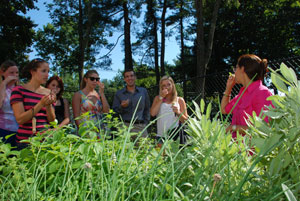Planting the Seed to Make a Seedling
A focus on growing lettuce and basil
By Leah Peterson and Jennifer Markowitz, Havemeyer Edible Garden Volunteers
Being Purposeful
When planning your edible garden, one of the most important details to consider is the kinds of fruit and vegetables that you most frequently eat. While planting a garden is an excellent opportunity to introduce new fruits and vegetables into your diet, you might become overwhelmed when harvesting a summer’s worth of kale if you’re not accustomed to eating it or familiar with cooking it.
With this in mind, we experimented planting our own lettuce and basil and documented the growth of each. Jennifer decided to grow lettuce from seed while Leah chose to tend a grown basil plant.
Lettuce
By Jennifer Markowitz
Lettuce – one of the most low-maintenance veggies to both grow and eat – has long been a staple in my diet. I thought that growing my own lettuce would inspire me to eat salads more often and to think of unique ways to incorporate it into my meals.
I was very hesitant the first day I planted the seeds, sprinkling them over a bed of composted soil. I imagined lettuce was a fragile plant that might not withstand Jersey’s sky-high temperatures and constant humidity. To my pleasure, my plants have continued to thrive even with the summer’s unusually brutal rainstorms and heat waves. Providing extra water and even occasional shade can help your plant survive very hot days.
Lettuce is amenable to a variety of climates and growing conditions, making it a great addition to any garden. I planted one batch in early April. The plants were fruitful all summer long and grew new leaves as I cut some to eat. More recently, in mid-August, I planted a second batch that has only just begun to sprout a few days after planting. While lettuce cannot withstand frost, it does grow in New Jersey’s spring, summer and fall weather, meaning you can plant it virtually all over the U.S.

Students in Ramapo’s Sustainable Living Residences take in the rich aromas of basil and sage.
Basil
By Leah Peterson
I have planted basil every summer for the past 10 years. Basil and other herbs are easy to grow and convenient to have on hand, as store-bought fresh herbs are often expensive and spoil quickly.
You can grow basil by planting the seed in the early spring and keeping it in a warm, bright, indoor location until the summer. Or, because basil is such a very common edible, you can also buy a plant that is already flourishing, as I did. Both seeds and pre-grown plants are commonly available from gardening centers, nurseries or farmers markets. This year I bought a six-inch basil plant at a local farmers market and planted it in a pot at home, which I keep on my front stoop where it receives continuous sunlight.
In addition to requiring a full day of sun, basil needs water daily. While I water the plant every day that it does not rain, New Jersey’s intense summer rains are helpful for replenishing the plant’s water after humid, sunny days.
The best part about basil is that with just a little trimming when the plant starts to flower, it will continue to produce fresh leaves throughout the summer, even when you use it as frequently as I do. Because it is so easy to simply cross the deck to the basil plant to cut off some leaves, my family has come to rely on having fresh basil around in the summer. We use it in a variety of our favorite summer dishes such as pesto and salads with tomato and mozzarella throughout the season.
Stay tuned for more posts!

